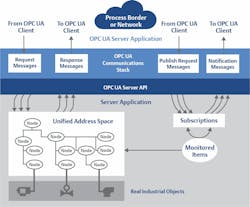Security, interoperability, speed make OPC UA attractive
Steve Ward is the EMEA director of application engineering, Controls & Software at Discrete Automation, Emerson. In his role, Steve leads the pre-sales support team for machine automation in the Europe, Middle East and Africe (EMEA) region. In addition, he serves as a pre-sales application engineer and solution architect. Steve has nearly 40 years of experience in the industrial automation industry and earned his master of scienece (MSc) degree in information systems management.
What have been the most significant advancements/changes in technology that have affected open platform communications unified architecture (OPC UA) acceptance/implementation in the past five years?
Steve Ward, EMEA director of application engineering, Controls & Software at Discrete Automation, Emerson: While OPC UA continues to mature, the underlying OPC UA technology has been suitable for a wide variety of applications for many years now. Adoption of OPC UA is driven by several factors, one of the most important being cybersecurity. The ability for OPC UA messages to be signed and encrypted with passwords and certificates means that OPC UA is easy to secure, and the security may be extended to cover the most stringent requirements. As cyber-attacks increase, and as legacy systems are replaced, users are looking for the most secure technology available, and OPC UA meets that requirement. OPC UA also performs well in applications that need a combination of current, historian and alarm data, since it is one of the only protocols that combines all three types of data into a single protocol. Support for structures is also useful because, instead of offering data as a set of unconnected variables, a structure can combine related data pertaining to a single device. For example, a motor structure can include status, start/stop commands, alarms and motor current, all in a single place.
What’s the most innovative or efficient OPC UA application you’ve ever seen or been involved with?
Steve Ward, EMEA director of application engineering, Controls & Software at Discrete Automation, Emerson: One of our system integrators implemented a data-logging solution collecting 20,000 I/O tags every second. This is an extremely high throughput and an indication of the performance possible using OPC UA.
How has OPC UA benefitted from the proliferation of components from multiple suppliers in machinery?
Steve Ward, EMEA director of application engineering, Controls & Software at Discrete Automation, Emerson: OPC UA is open and adopted by many vendors, allowing interoperability of equipment, which is a major benefit for users. As users look to replace legacy equipment, open protocols that are easy to use and that are secure are replacing legacy protocols that are restricted to one or a few vendors and that do not offer any security.
Can you explain how Industry 4.0 initiatives or the Industrial Internet of Things has impacted the use of OPC UA in manufacturing?
Steve Ward, EMEA director of application engineering, Controls & Software at Discrete Automation, Emerson: Industry 4.0 and the Industrial Internet of Things (IIoT) have driven adoption of OPC UA. There is a realization throughout industry that plant-floor devices contain an incredible amount of useful data. That data can be collected and turned into information that can reduce downtime, reduce scrap, reduce operating costs and increase efficiency. The technology itself is becoming easier to use, and the growth of similar technology in the consumer and commercial world is raising awareness; however, there remains a skills gap in the automation industry. The growth of sustainability efforts is also driving adoption of new technologies.
Do you find OPC UA more useful in small embedded systems of larger cloud-based applications?
Steve Ward, EMEA director of application engineering, Controls & Software at Discrete Automation, Emerson: OPC UA is useful in both small embedded systems and for larger cloud-based applications. In small applications, the ability to browse data means that a system can be configured very quickly without having to understand a complex data structure. In larger applications, the ability to send enormous amounts of data securely is often key. OPC UA also includes context about the data that can make it more useful than protocols like message queuing telemetry transport (MQTT) that do not attempt to define the data, although efforts like Sparkplug mean that MQTT may also be used more easily in larger applications.
How have the security and scalability of OPC UA made it more user-friendly?
Steve Ward, EMEA director of application engineering, Controls & Software at Discrete Automation, Emerson: Scalability in terms of OPC UA means that users can start with small applications and grow them without worrying about hitting a performance or capacity limit at a later date. This is of great benefit for many users. Larger systems can implement OPC UA browsers and discovery servers to make it easier to find data on the corporate network. Security and ease of use are often opposed, but the growth of tools like Emerson’s PAC Security Centre allows non-technical users to implement security more easily. Most vendors need to do more to make security easier to use, though.
What future innovations will impact the use of OPC UA in manufacturing operations?
Steve Ward, EMEA director of application engineering, Controls & Software at Discrete Automation, Emerson: Well-defined data structures make it much easier for users to work with data. Special interest groups can also consider defining their own structures specific for their industries and applications. The addition of the Engineering Units specification will add further context to data. The growth of peer-to-peer capabilities, such publish-subscribe (PubSub), will simplify interdevice communications. Currently this often needs an additional device such as an industrial PC with human-machine interface (HMI)/supervisory control and data acquisition (SCADA) software and associated configuration or scripting. But overall I think the biggest innovation will be the continued increase in computing power along with reductions in cost. These will allow more devices to become intelligent and able to support protocols such as OPC UA natively without needing expensive gateways and without requiring external tools—for example, an intelligent device can be configured using a built-in web server.
Anything else that you'd like to add about OPC UA?
Steve Ward, EMEA director of application engineering, Controls & Software at Discrete Automation, Emerson: OPC UA has great promise to replace many legacy protocols, including de facto standard protocols like Modbus that are not standardized and offer no security, along with more advanced industry protocols like distributed network protocol 3 (DNP3) and IEC 61850 that are expensive and difficult to implement.
About the Author
Mike Bacidore
Editor in Chief
Mike Bacidore is chief editor of Control Design and has been an integral part of the Endeavor Business Media editorial team since 2007. Previously, he was editorial director at Hughes Communications and a portfolio manager of the human resources and labor law areas at Wolters Kluwer. Bacidore holds a BA from the University of Illinois and an MBA from Lake Forest Graduate School of Management. He is an award-winning columnist, earning multiple regional and national awards from the American Society of Business Publication Editors. He may be reached at [email protected]

Leaders relevant to this article:


